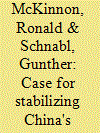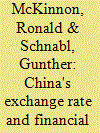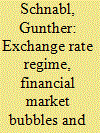|
|
|
Sort Order |
|
|
|
Items / Page
|
|
|
|
|
|
|
| Srl | Item |
| 1 |
ID:
086472


|
|
|
|
|
| Publication |
2009.
|
| Summary/Abstract |
China's financial conundrum arises from two sources. First, its large saving (trade) surplus results in a currency mismatch because it is an immature creditor that cannot lend in its own currency. Instead, foreign currency claims (largely US dollars) build up within domestic financial institutions. Second, economists, both American and Chinese, mistakenly attribute the surpluses to an undervalued RMB. To placate the USA, the result was a gradual and predictable appreciation of the RMB against the dollar of 6 percent or more per year from July 2005 to July 2008. Together with the fall in US interest rates since mid-2007, this oneway bet in the foreign exchanges markets not only attracted hot money inflows but inhibited private capital outflows from financing China's huge trade surplus. Therefore, the People's Bank of China had to intervene heavily to prevent the RMB from ratcheting upwards, and so became the country's sole international financial intermediary as official exchange reserves exploded. Because of the currency mismatch, floating the RMB is neither feasible nor desirable, and a higher RMB would not reduce China's trade surplus. Instead, monetary control and normal private-sector finance for the trade surplus require a return to a credibly fixed nominal RMB/USD rate similar to that which existed between 1995 and 2004. However, for any newly reset RMB/USD rate to be credible as a monetary anchor, foreign "China bashing" to get the RMB up must end. Then the stage would be set for fiscal expansion to both stimulate the economy and reduce its trade surplus.
|
|
|
|
|
|
|
|
|
|
|
|
|
|
|
|
| 2 |
ID:
131397


|
|
|
|
|
| Publication |
2014.
|
| Summary/Abstract |
Instability in the world dollar standard, as most recently manifested in the US Federal Reserve's near-zero interest rate policy, has caused consternation in emerging markets with naturally higher interest rates. China has been provoked into speeding RMB "internationalization"; that is, opening up domestic financial markets to reduce its dependence on the US dollar for invoicing trade and making international payments. However, despite rapid percentage growth in offshore financial markets in RMB, the Chinese authorities are essentially trapped into maintaining exchange controls (reinforced by financial repression in domestic interest rates) to avoid an avalanche of foreign capital inflows that would threaten inflation and asset price bubbles by driving nominal interest rates on RMB assets down further. Because a floating (appreciating) exchange rate could attract even more hot money inflows, the People's Bank of China should focus on keeping the yuan/dollar rate stable so as to encourage naturally high wage increases to help balance China's international competitiveness. However, further internationalization of the RMB, as with the proposed Shanghai pilot free trade zone, is best deferred until world interest rates rise to more normal levels.
|
|
|
|
|
|
|
|
|
|
|
|
|
|
|
|
| 3 |
ID:
168770


|
|
|
|
|
| Summary/Abstract |
For a long time, China's impressive growth performance has been driven by investment and high productivity gains. Based on a discussion of possible overcapacities and overinvestment in China, this paper investigates the sustainability of China's investment and export‐driven growth model. Since the turn of the millennium, buoyant capital inflows and low interest rates have been at the root of overinvestment and misallocation of capital, which necessitated export subsidies to clear markets. The overinvestment boom is argued to have ended around 2014. Since then, the overcapacities have weakened China's bargaining position in the US–Chinese trade conflict and have tempted Chinese authorities to postpone the restructuring of the Chinese economy by providing low‐interest credit. The gradual reemergence of quasi‐soft budget constraints is seen to undermine China's long‐term growth potential.
|
|
|
|
|
|
|
|
|
|
|
|
|
|
|
|
| 4 |
ID:
152507


|
|
|
|
|
| Summary/Abstract |
Since 2014, capital inflows into China have turned into capital outflows, reversing the gradual appreciation path of the renminbi against the US dollar into an erratic depreciation path. The paper explains the current capital outflows by comparing China and Japan with respect to the impact of exchange rate expectations on speculative capital flows. It is argued that both in China and Japan, given benign liquidity conditions in the USA, policy-induced appreciation expectations have generated capital inflows that have contributed to overinvestment and financial market bubbles. The current reversal of capital flows is seen as a signal that the bubble in China has burst. To stabilize growth in China and to discourage speculative capital outflows a fixed exchange rate to the dollar is recommended. Given Japan's experience and given that China's foreign assets remain high, the depreciation pressure on the Chinese renminbi can be expected to abate.
|
|
|
|
|
|
|
|
|
|
|
|
|
|
|
|
| 5 |
ID:
156439


|
|
|
|
|
| Summary/Abstract |
The paper analyzes the role of monetary policy for cyclical movements of investment and asset markets in East Asia and Europe based on a Mises-Hayek overinvestment framework. It is shown how the gradual global decline of interest rates has triggered wandering overinvestment cycles in Japan, Southeast Asia, and China. Similarly, it is shown how a one-size monetary policy within the European Monetary Union has not preserved the European Monetary Union from idiosyncratic economic development and crisis because of uncoordinated fiscal policies. With monetary policy crisis management being argued to impede financial and economic restructuring, a timely exit from ultra-expansionary monetary policies is recommended for both East Asia and Europe to reconstitute economic stability and growth.
|
|
|
|
|
|
|
|
|
|
|
|
|
|
|
|
|
|
|
|
|